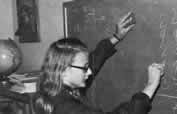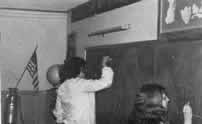 |
Volume I, No. 1, Fall 1973 |
Ciphering
What can be more embarrassing to a sophomore in high school than getting beaten in math by a fourth grader? The sophomore was me and it was in a ciphering match that I was beaten. Small consolation was the fact that I had never ciphered before and he ciphered nearly every Friday all year.
Ciphering, played in the one-room rural schools for many, many years, is a contest between two teams to help the boys and girls learn their math. Nearly every Friday the children ciphered, either in their own school or in matches with neighboring schools. It is very surprising how fast and accurate they became in math.
Ciphering is a very good method for learning arithmetic. There would be a great loss if it were to die away with the one-room school, and because of this, I will include instructions in hope that ciphering will remain part of our heritage.
In ciphering, two people race to see who can work the problem the quickest. The person who gets the correct answer and first calls it out correctly wins that problem. Sometimes people lose by reading the answer incorrectly, or too slowly, even though they worked it correctly before their opponent.
To prepare for the game, two students in the class pick teams. The best cipherers would be picked first, then on down to the children who weren't as fast or advanced, even a preschooler who might be visiting. As the captains choose their team members, they write the names on the blackboard in the order they were picked. The last two chosen were the first contestants with the one chosen last being the challenger. The challenger gets to pick what type of math he wants to use for the first problem. The problem can by anything related to math: addition, subtraction, multiplication, division, fractions, decimals, even the use of marks.
A small child who hasn't used the other types of math very much can choose to make marks on the board. The teacher tells them when to start, and they make as many marks as they can until the teacher says stop. The person with the most marks wins. The other contestant then gets to choose what type of problem he will work next. Contestants alternate choosing until one wins two out of three tries.
The loser erases his name from the board and sits down, and the next one on the list becomes the new challenger. A person stays at the board to do problems as long as he wins, sometimes turning down several people or the whole school. Some of the good cipherers could have the problem worked before the teacher had hardly finished giving out the numbers. It was nothing for some to add one or two columns of a long addition problem while the teacher was calling out the problem.
Ciphering was not done just by the students. At pie suppers, on the last day of school, or at other events when the patrons of the school district would be at the school, adults would cipher with the children, usually quickly turning them down.
Anyone can have fun in a ciphering match whether young or old, big or little. Since the elementary classes are not growing now at such a great rate, then maybe ciphering will revive in today's modern schools.
[39]
Copyright © 1981 BITTERSWEET, INC.
Next Article | Table of Contents | Other Issues


